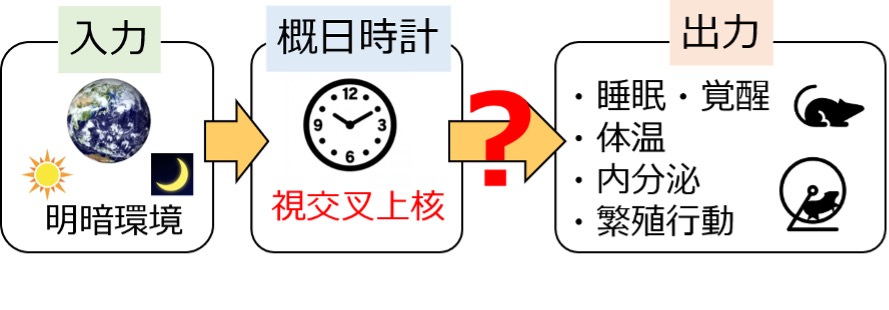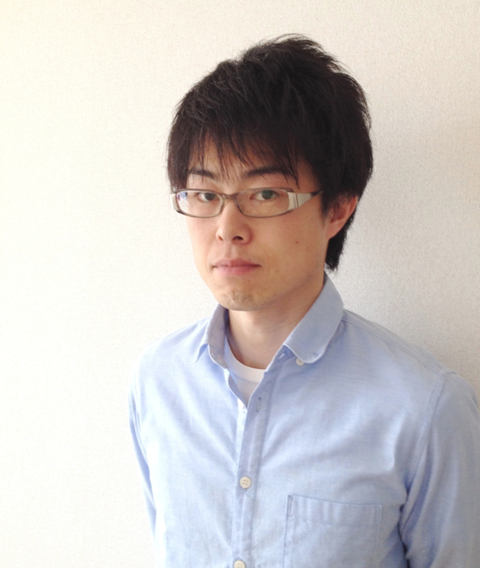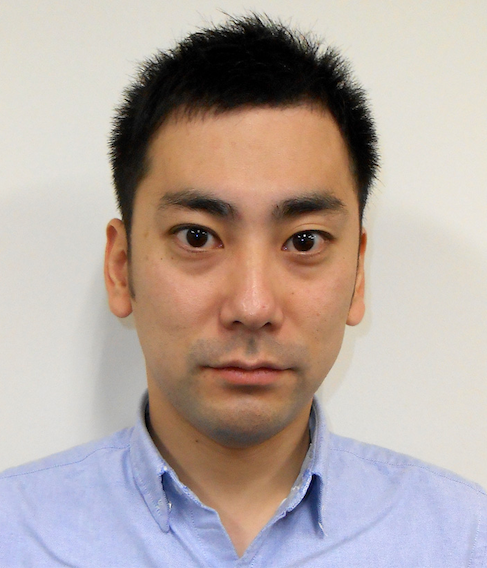所内プロジェクトセクション

研究内容
本研究室では、マウスやハムスターをモデル動物として、動物行動の基盤となる神経回路機構を研究しています。特に、睡眠覚醒や摂食行動など本能行動を調節する視床下部神経回路の機能は研究室の中心テーマになっています。様々な遺伝子改変動物やウイルスベクターを作成・利用して、オプトジェネティクス(光遺伝学)やDREADD(薬理遺伝学)などの最新の神経活動操作技術や運命制御などによって摂動を与え、その結果表出する動物個体の行動・生理の変化を多角的に解析しています。分子から動物個体までを幅広く扱い、分子・細胞・シナプスレベルでの現象と神経回路機能・行動発現を繋げることで、動物行動の動作原理の統合的理解と疾患との関連について明らかにすることが目標です。
1. 概日時計による行動・生理機能のタイミングを決める神経メカニズム(小野ユニット) 私たちは、時刻や光の情報が一切ない部屋で生活をしても、睡眠・覚醒や体温はおよそ24時間周期で変動します。このおよそ24時間のリズムを「概日リズム」と呼び、「概日時計」がその調節を担います。動物が1日のうち最適な時間に睡眠、繁殖、摂食などを行う事は、地球上で種を残すための極めて重要な生存戦略の1つです。また動物は季節により、繁殖機能や生理機能を劇的に変化させることで、厳しい環境を乗り越えています。しかし、これらの動物行動や生理機能のタイミングを調節する神経メカニズムはよくわかっていません。私たちの研究チームは、動物が示す行動や生理機能のタイミングを調節する、神経回路の動作原理の理解を目指しています。そのため、光操作や光イメージングや電気生理学、組織学、動物行動学に加え、ウイルスベクターやin vivoゲノム編集等の技術を総動員し、概日時計の中枢である視床下部に位置する「視交叉上核」を起点とした脳内神経ネットワークの全貌解明を目標とします。詳しくは以下個別HPをご参照ください。個別HPへ

これまでの代表的な成果: Ono et al., 2023 Science Advances, Ono et al., 2020 Science Advances, Ono et al., 2019 Communications Biology, Ono et al., 2017 PNAS, Ono et al., 2016 Science Advances, Ono et al., 2013 Nature Communications
2. 冬眠・休眠を制御する神経回路の解析(山口ユニット) 一部の動物は生存が困難な環境において、休眠(英語ではtorpor)と呼ばれる低体温・低代謝状態に入り、エネルギーを節約して生き延びることができます。休眠はその期間の長さから2種類に分類され、冬期に数日間から数週間に渡って休眠に入ることを「冬眠」、24時間以内に終了する休眠を「日内休眠」と呼びます。これまでにげっ歯類や霊長類を含む200以上の動物種が冬眠・休眠に入ることが知られています。 中枢神経系、特に脳の視床下部が、体内の栄養状態、環境温度、概日・概年リズムなどの情報を統合し、冬眠や休眠の開始・維持・終了を制御すると考えられていますが、まだその詳細なメカニズムはわかっていません。私たちのグループでは、マウスやハムスターをモデルとして、透明脳を用いた全脳スクリーニング、光遺伝学、in vivo遺伝子編集技術などを用いて、冬眠・休眠を制御する神経回路の解明に取り組んでいます。詳しくは以下個別HPをご参照ください。 個別HPへ
研究業績
発表論文
- *Ono, D., Wang, H., Hung, J.C., Wang, T.H., Kon, N., Yamanaka, A., Li, Y., and Sugiyama, T. Network-driven intracellular cAMP coordinates circadian rhythm in the suprachiasmatic nucleus. Science Advances 9(1), DOI: 10.1126/sciadv.abq7032, 2023.
- *Ono, D., Mukai, Y., Hung, J.C., Chowdhury, S., Sugiyama, T., and *Yamanaka, A. The mammalian circadian pacemaker regulates wakefulness via CRF neurons in the paraventricular nucleus of the hypothalamus. Science Advances 6:45, 10.1126/sciadv.abd0384, 2020.
- *Ono, D., *Honma, S., Nakajima, Y., Kuroda, S., Enoki, R., and Honma, K.: Dissociation of Per1 and Bmal1 circadian rhythms in the suprachiasmatic nucleus in parallel with behavioral outputs. Proc. Natl. Acad. Sci. U S A. doi: 10.1073/pnas.1613374114, 2017.
- Ono, D., Honma, S., and Honma, K.: Differential roles of AVP and VIP signaling in the postnatal changes of neural networks for coherent circadian rhythms in the SCN. Science Advances 2, e1600960, 2016.
- Ono, D., Honma, S., and Honma, K.: Cryptochromes are critical for the development of coherent circadian rhythms in the mouse suprachiasmatic nucleus. Nature Communications 4:1666 doi: 10.1038/ncomms2670, 2013.
- Yamaguchi, H., Murphy, K., Fukatsu, N., Sato, K., Yamanaka, A., de Lecea, L. (2023).Brain-wide mapping of neuronal architecture controlling torpor. bioRxiv.
- Li, S.-B., Damonte, V. M., Chen, C., Wang, G. X., Kebschull, J. M., Yamaguchi, H., … Others. (2022). Hyperexcitable arousal circuits drive sleep instability during aging. Science, 375(6583), eabh3021.
- Li, S.-B., Borniger, J. C., Yamaguchi, H., Hédou, J., Gaudilliere, B., & de Lecea, L. (2020). Hypothalamic circuitry underlying stress-induced insomnia and peripheral immunosuppression. Science Advances, 6(37), eabc2590.
- Yamaguchi, H., and de Lecea, L. (2019). In vivo cell type-specific CRISPR gene editing for sleep research. Journal of Neuroscience Methods, 316, 99–102.
- Yamaguchi, H., Hopf, F. W., Li, S.-B., and de Lecea, L. (2018). In vivo cell type-specific CRISPR knockdown of dopamine beta hydroxylase reduces locus coeruleus evoked wakefulness. Nature Communications, 9(1), 5211.
著書・総説
- *Ono, D. Neural circuits in the central circadian clock and their regulation of sleep and wakefulness in mammals. Neuroscience Research doi.org/10.1016/j.neures.2022.05.005, 2022.
- *Ono, D., Honma, K., and *Honma S. Roles of Neuropeptides, VIP and AVP, in the Mammalian Central Circadian Clock. Frontiers in Neuroscience 15:650154. doi: 10.3389/fnins.2021.650154, 2021.
- Ono, D., Honma, K., and Honma, S.: GABAergic mechanisms in the suprachiasmatic nucleus that influence circadian rhythm. Journal of Neurochemistry doi: 10.1111/jnc.15012, 2020.
- *Ono, D., Honma, K., Yanagawa, Y., Yamanaka, A., and Honma, S.: Role of GABA in the regulation of the central circadian clock of the suprachiasmatic nucleus. Journal of Physiological Science 68:333-343, 2018.
- Ono, D., and Yamanaka, A.: Hypothalamic regulation of the sleep/wake cycle. Neuroscience Research 118:74-81, 2017.



